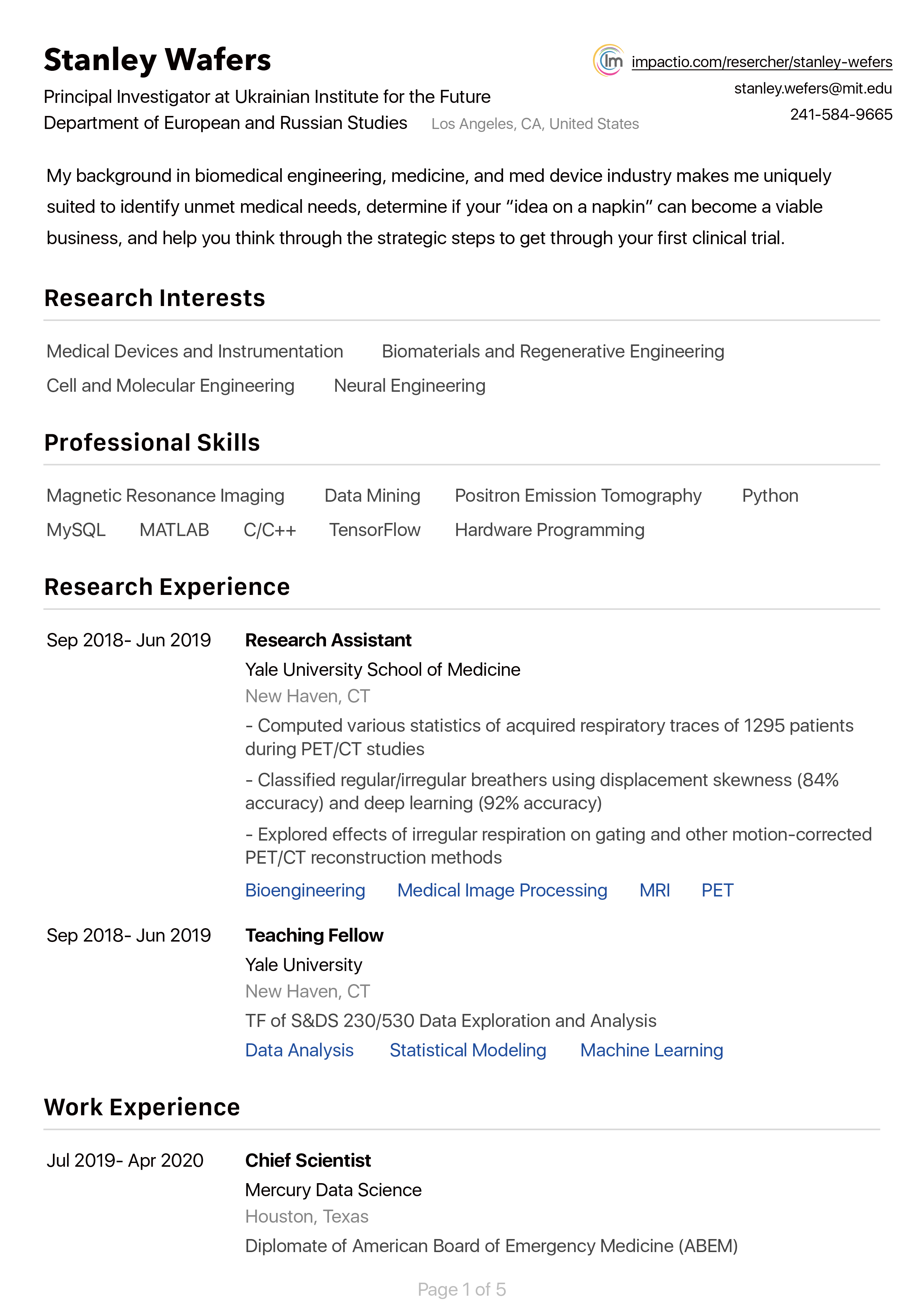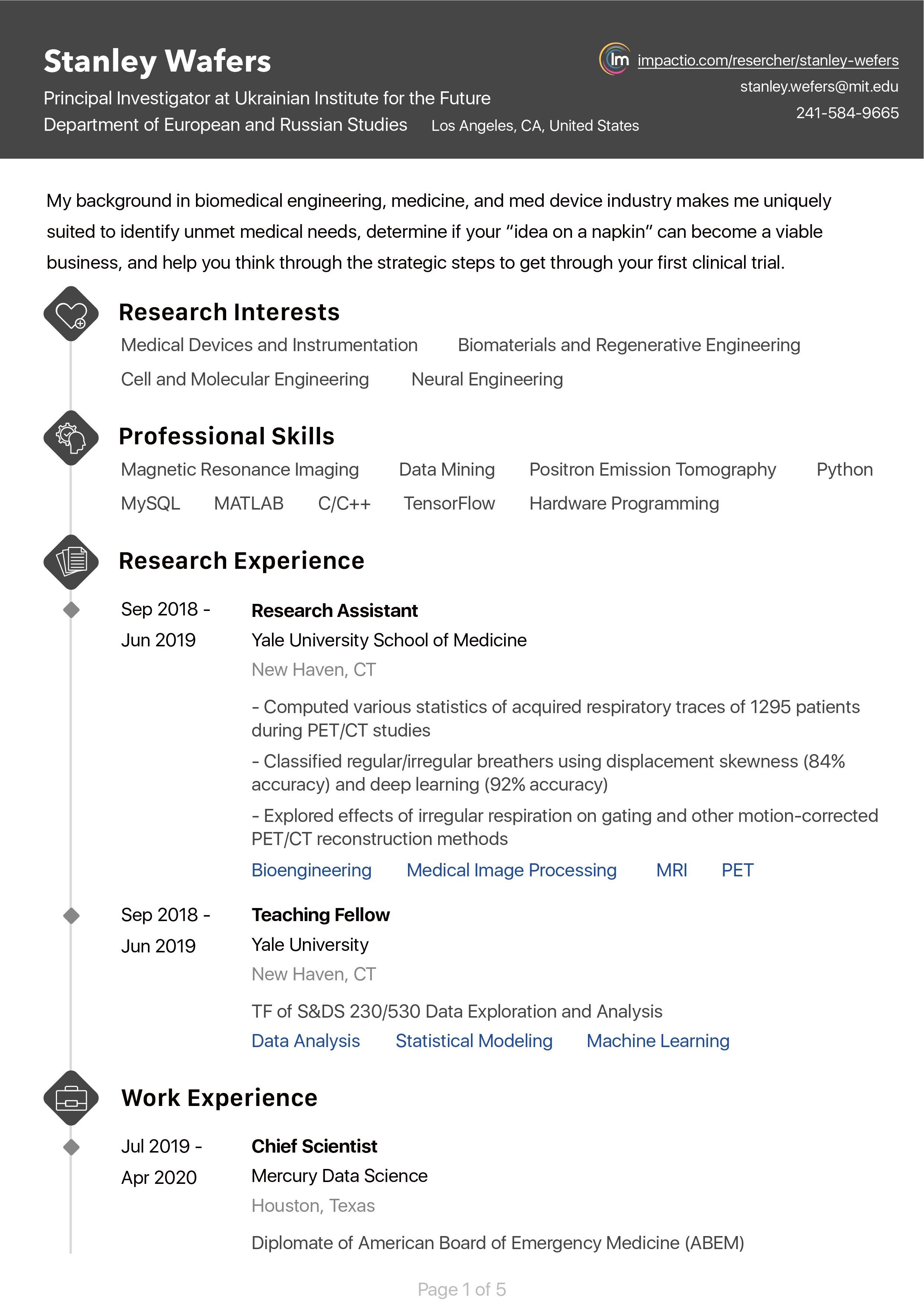1°) Principal Investigator, Author in ’comparative study of the effects of clonidine and diltiazem in the prevention of addiction signs and symptoms during ultrarapid opiate detoxification under general anesthesia’ (unpublished work),University Hospital Brugmann, ULB, Brussels, Belgium 2000-2001.
2°) Co-Investigator in’ Clinical Trial NCT01167803, Anesthesia for obese patients :desflurane versus xenon, phase 4 Study’ ;192 patients included from December 2010 to November 2012, Multicentric study, CHU Caremeau, Nimes, France.
3°) Co-Investigator Clinical Study NCT01282996, Prospective randomized intraoperative protective ventilation inabdominal surgery, phase 4 Study ; 400 patients included from January 2011 to August 2012 ,multicentric Study, CHU Caremeau, Nimes, France.
4°)Principal Investigator, Author, Statistic analysis and Scientific Coordinator in’ A Survey of pediatric anesthesia practice for magnetic resonance imaging in French hospitals’ ,Centre Hospitalier Universitaire Caremeau, Nimes, France, October 2013 .
5°) Investigator in ‘Study on the Efficacy and Safety of a Therapeutic Strategy of PPH Comparing Early Administration of Human Fibrinogen vs Placebo in Patients Treated with IV Prostaglandins Following Vaginal Delivery EudraCT Number 2013-002484-26 ; NCT02155725 Fibrinogen in Haemorrhage of Delivery (FIDEL)’ ; national multicentric randomized double blinded controlled trial, Necker Enfants Malades University Hospital, Paris, France 2016-2017.
6°)Principal Investigator, Author, Statistic analysis and Scientific Coordinator in ‘Transfusion and Morbi-Mortality Factors: An Observational Descriptive Retrospective Pediatric Cohort Study’, Necker Enfants Malades University Hospital, Paris, France 2017.
7°)Principal Investigator, Author, Statistic analysis and Scientific Coordinator in’ A retrospective descriptive cohort study of preoperative, intraoperative and postoperative management of children in scoliosis surgery’, University Children’s Hospital Queen Fabiola, Brussels, Belgium Mai 2018.
8°)Principal Investigator, Author, Statistic analysis and Scientific Coordinator in ’A Systematic Review and Meta-analysis of Intraoperative Goal Directed Fluid and Haemodynamic Therapy in Children and Postoperative Outcome [CRD42018103119]’ Necker Enfants Malades University Hospital, Paris, October 2018.
9°)Principal Investigator, Author, Statistic analysis and Scientific Coordinator in ‘A Systematic Review and Meta-analysis of Goal Directed Intraoperative Transfusion Protocols Guided by Viscoelastic Methods and Perioperative Outcomes in Children [CRD42018103163]’ Necker Enfants Malades University Hospital, Paris, January 2019.
10°) Principal Investigator, Author, Statistic analysis and Scientific Coordinator in ‘Rapid Recovery Pathways After Surgery in Children: A Systematic Review and Meta-analysis [CRD42018103518]’ Necker Enfants Malades University Hospital, Paris, April 2019.
11°) PhD Thesis Project, Principal Investigator, Author, Statistic analysis and Scientific Coordinator in ‘Do goal directed therapies improve postoperative outcome in children ? (Perioperative Goal Directed Fluid and Hemodynamic Therapy ; Transfusion goal directed therapy using viscoelastic methods and enhanced recovery after surgery and Postoperative outcome)’ Paris Descartes University, University of Paris, Paris France 2019 http://www.theses.fr/s232762.
12°)Principal Investigator, Statistic analysis and Manuscript writing of the observational prospective multicentric study entitled’Clinical, obstetrical and anaesthetic analysis of pregnant women with coronavirus disease 2019 in labor and delivery: a prospective multicentre observational cohort study from the The Obstetric Anaesthesia COVID-19 Collaboration Network from 18 March 2020 to 30 September 2020.
13°)Principal Investigator, Author, Statistic analysis and Scientific Coordinator of ‘Trans-thoracic Echocardiographic Aortic Blood Flow Peak Velocity Variation, Distance Minute, Aortic Velocity Time Integral and Postoperative Outcome in Pediatric Surgical Patients-An Observational Pilot Study (2020)’ published in Open Journal of Internal Medicine,10, 90-95.https://doi.org/10.4236/ojim.2020.101009
14°)Principal Investigator, Author, Statistic analysis and Scientific Coordinator of ’Goal directed fluid and hemodynamic therapy and postoperative outcomes in children: Value of trans-thoracic echocardiographic aortic blood flow peak velocity variation: A multicentre randomized controlled trial protocol (2020)’ published in Advances in Pediatric Research 7:35. doi: 10.35248/2385-4529.20.7.35
1.) Postgraduate in anesthesiology from 2001 to 2006 :
-University Hospital Brugmann and University Children’s Hospital Queen Fabiola,ULB, Brussels, Belgium : adult, pediatric anesthesia, critical care medicine, emergency care medicine.
-University Hospital Saint-Pierre, ULB, Brussels , Belgium: adult and pediatric anesthesia.
-University Hospital Erasme, ULB, Brussels, Belgium : adult and pediatric anesthesia
2.) Anesthesiologist from 2006 to 2008 :
-University Hospital Brugmann and University Children’s Hospital Queen Fabiola, ULB, Brussels, 2006-2007 : adult and pediatric anesthesia ; adult critical care.
-University Hospital Erasme, ULB, Brussels : Resident in Intensive Care 2007.
-University Hospital Saint-Pierre, ULB, Brussels : adult and pediatric anesthesia 2008-2008.
3.) Hospital medical doctor in anesthesiology :
-University Hospital of Pointe-a-Pitre /Abymes (Guadeloupe) 2008-2009 : adult and pediatric anesthesia.
-University Hospital Nîmes : hospital medical doctor in anesthesiology from 2009 to 2014 adult, pediatric anesthesia and intensive care.
-University Hospital Necker Enfants Malades (Paris) : Hospital Medical Doctor in Pediatric and Obstetric Anesthesiology since October 2014.
- University Children’s Hospital Queen Fabiola (Hopital Universitaire Des Enfants Reine Fabiola, HUDERF), ULB, Brussels, from September 2017 until July 2018 as deputy head of clinic in pediatric anesthesia.
-University Hospital Necker Enfants Malades, Assistance Publique Hôpitaux de Paris Paris : Pediatric and Obstetric Anesthesiologist since October 2014 .



de 2011 à septembre 2014 :Anesthésie pédiatrique; digestive;radiologie interventionnelle.
Unité de Soins Continus Chirurgicaux.
Anesthésie obstétricale (garde).




1)Secondary School Graduation Diploma (Science and Mathematics) in 1985-1991 at Athénée Léon Lepage, Brussels, Belgium
2) Medical Doctor Diploma : Free University of Brussels 1991-2001, Brussels (Universite Libre de Bruxelles, ULB)
3)Anesthesiology Inter-university Diploma, Free University of Brussels 2001-2006,Brussels, Belgium (Universite Libre de Bruxelles, ULB).
4)Medical Hospital Doctor, Concours national de praticien hospitalier 2009-2010, Paris, France.
5) Pediatric Anesthesia Inter–university Diploma, University of Aix Marseille 2009- 2010, Marseille, France.
6) Echocardiography applied to Anesthesia and Critical Care Inter-university Diploma, University of Montpellier 1, 2011-2012, Montpellier, France.
7) Hypnosis applied to acute pain therapy and anesthesia, University Hospital of Nimes, Nimes 2012-2013, France.
8) Intensive and Critical care Diploma, University of Montpellier 1, 2013-2014, Montpellier, France



Chez l’adulte, il y a de plus en plus d’évidence que l’optimisation hémodynamique du remplissage vasculaire en peropératoire, la transfusion à objectif dirigé utilisant les méthodes viscoélastiques et la réhabilitation précoce après chirurgie améliorent le pronostic postopératoire après chirurgie. Chez l’enfant, l’évidence concernant ce sujet n’est pas très clairement établie.
Objectifs de ce projet de Thèse :
Clarifier l’impact de ces thérapies à objectifs dirigés sur l’évolution post-opératoire chez l’enfant.
Méthodes :
Dans un premier temps un état des lieux actuel a été réalisé et dans un deuxième temps, une étude prospective (randomisée) sera conceptualisée et mise en place. Etant donné que ce qui a été validé chez l’adulte ne peut pas être extrapolé systématiquement chez l’enfant, il est nécessaire de développer des études spécifiques chez l’enfant vu que la physiologie et la physiopathologie surtout à des âges extrêmes sont différentes de celles de l’adulte.

Speaker and Presentation of ''Postoperative Outcome in Non-Preterm Infants Under One Year Old in Non-Cardiac Surgery'
https://zenodo.org/record/4958069#.YMyjVy0RpQI
Abstracts Presentation of '’Pre-term Infants in Major Abdominal Surgery and Postoperative Outcome’’; ‘’Hemoglobin Levels and Postoperative Outcome in Pediatric Surgical Patients’’
Speaker, Plenary Presentation 'Veno-venous extracorporeal membrane oxygenation (ECMO) in a child with hemoptysis and Fontan circulation'
Organizing committee/ Speaker 'Perioperative Echocardiographic Hemodynamic Parameters and Postoperative Outcome in Pediatric Surgical Patients: Descriptive Observational Pilot Studies'
At Webinar on 5th World Congress on Advanced Clinical Research
Abstract presentation at 11th European Society for Paediatric Anaesthesiology Congress Rotterdam, Netherland.
'A Systematic Review and Meta-analysis of Goal Directed Intraoperative Transfusion Protocols Guided by Viscoelastic Methods and Perioperative Outcomes in Children’
Poster-Abstract presentation of ' A systematic review and meta-analysis of intraoperative goal directed fluid and hemodynamic therapy in children and postoperative outcome [CRD42018103119] ' (Conference on Principles of Pediatric Anesthesia and Critical Care) at Havard Medical School: Boston, MA, US
Invited Speaker at 13th International Conference on Pediatrics and Neonatal Healthcare London, GB
Invited Position: Abstract Presentation Moderator at 10 th European Society for Paediatric Anaesthesiology Congress Brussels, BE
Background: An observational study conducted previously to determine predictors of postoperative outcome in pediatric abdominal surgery, orthopedics and neurosurgery revealed that factors which influenced postoperative evolution were multiple. These included American Society of Anesthesiologists (ASA) score, transfusion, age, emergency surgery, and surgery.
Objectives: To describe outcomes in children aged between 1 and 3 years old included in the initial study.
Methods: Secondary analysis of the initial retrospective observational study in 594 patients with a mean age of 90.86±71.80 months. The study was approved by the Ethics Committee under the registration number 2017-CK-5-R1.
Results:
There were 79 children with a mean age of 22.04±7.15 months. The majority of the patients (36.71%) were American Society of Anesthesiologists (ASA) grade 3. There were 37 neurosurgical (46.83%), 34 abdominal surgical (43.04%) and 8 orthopedic patients (10.13%).
The most common interventions were craniosynostosis in 16 patients (20.25%), intestinal resection in 13 patients (16.45%), intracerebral tumor resection in 7 patients (8.86%), neuroblastoma in 5 patients (6.30%), liver transplantation in 3 patients (3.79%) and renal transplantation in 2 patients (2.53%).
20 patients (25.32%) had intra-operative and or postoperative complications. 4 patients (5.06%) had re-operations. 2 patients (2.53%) had intra-operative broncho-laryngospasm. 3 (3.78%) patients had intra-operative hemorrhagic shock. 6 (7.59%) patients had cardio-circulatory failure. 4 (5.04%) had neurologic failure. 1.27% of the patients had postoperative hepatic failure (1 patient), postoperative multiple organ failure (1 patient), postoperative respiratory failure (1 patient), postoperative renal failure (1 patient). The most common postoperative infections were septicemia in 5 patients (6.33%), pulmonary sepsis in 3 patients (3.79%), abdominal sepsis in 1 patient (1.27%) and surgical wound sepsis in 1 patient (1.27%).
46 patients (58.23%) had intra-operative transfusion.
The rate of in-hospital mortality was 2.53% (2 patients).
Conclusion: 25 % of the patients in this cohort had intra-operative and or postoperative complications. Outcome in surgical patients is multifactorial. Integrating goal directed therapies to optimize intra-operative patient management is one of the major keys to improve postoperative outcome in surgical patients.
Keywords: children aged between 1 and 3 years, non-cardiac surgery, postoperative outcome
Abstract
Background:
Previously published studies have revealed the multifactorial characteristics of predictors of postoperative outcome in surgical pediatric patients. We have undertaken a detailed description of these outcomes with regard to age.
Objective:
To describe postoperative outcomes in children aged between 3 and 6 years in children included in the initial retrospective observational study in children in neurosurgery, abdominal and orthopedic surgery.
Methods:
Secondary analysis of children between 3 and 6 years included in the initial retrospective study. The study was approved by the Ethics Committee.
Results:
There were 72 children included with a mean age of 52.2±10.3 months.
50% of the patients (36) were ASA grade 3. 15 patients (20.8%) underwent an emergency intervention.
The most common surgical interventions were intracerebral tumor resection in 11 patients (15.3%), neuroblastoma in 8 patients (11.1%), scoliosis in 7 patients (9.7%), craniosynostosis in 6 patients (8.3%), intestinal resection in 5 patients (6.9%), pelvic osteotomy in 4 patients (5.6%) and exploratory laparotomy in 4 patients (5.5%).
There were 20 patients (27.8%) who presented intra-operative and or postoperative complications. 4 patients (5.6%) had intra-operative hemorrhagic shock. The most common postoperative organ dysfunctions were respiratory failure in 5 patients (6.9%) and cardio-circulatory failure in 3 patients (4.2%). The most common postoperative infections were pulmonary sepsis in 3 patients (4.2%), abdominal sepsis in 3 patients (4.2%) septicemia in 3 patients (4.2%). 6 (8.3%) patients had re-operations. 43 (59.7%) patients were transfused intra-operatively. In-hospital mortality rate was 2.8% (2 patients). Median total length of hospital stay was 10 days [4-23.5].
Conclusion
27.8% of the patients presented with intra-operative and or postoperative complications. These patients were in majority ASA grade 3, that is to say high risk patients. Predictors of postoperative outcome are multifactorial, it is time to reconsider integrating goal directed therapies in high risk patients undergoing high risk interventions to improve postoperative outcome.
Keywords
Children aged between 3 and 6 years, neurosurgery, abdominal surgery, orthopedic surgery, postoperative outcome, goal directed therapies
Background: An observational study published in 2017 revealed transfusion as one of the predictive factor of outcome in surgical children in terms of organ dysfunction, length of intensive care unit stay, length of hospital stay and length of mechanical ventilation. Transfusion can be a necessity and life-saving intervention in patients. Balancing the benefits and risks of this therapeutic intervention is mandatory to improve patient outcome. Patient blood product management protocols reduce transfusion needs and length of hospital stay. A second analysis was undertaken to determine hospitalization costs in transfused and non-transfused patients in the observational study in children published in 2017.
Objectives: To determine the hospitalization costs of transfused and non-transfused patients of the observational study in 594 pediatric neurosurgery, abdominal and orthopedic surgery patients published in 2017.
Methods: Second analysis of the database of 594 pediatric surgical patients of the observational study published in 2017.
Results: Median total hospitalization costs in transfused patients were significantly twice higher {32041.97 euros [13983.82-59003.59]} than in non-transfused patients {14084.45 euros [8551.2-29124.55]}, p < 0.0001.
Keywords: Transfusion; Pediatric Surgical Settings; Hospitalization Costs
Background: Postoperative outcome in children is multifactorial. Among the reported predictors of postoperative outcome, preoperative anemia has been related to adverse outcome in children. A secondary analysis was undertaken to determine the correlation between hemoglobin levels and postoperative outcome in children included in a cohort of an observational pediatric study published previously since this analysis has not been done.
Objective: To determine the correlation between preoperative, intra-operative, postoperative hemoglobin levels and postoperative outcome in children in neurosurgery, abdominal and orthopedic surgery.
Methods: Secondary analysis of a sub-cohort of 252 pediatric surgical patients with a median age of 62 months [12.50-144.00].
Results: Preoperative hemoglobin levels were negatively correlated to length of stay in the intensive care unit (LOSICU) (p=0.002), to length of hospital stay (LOS) (p<0.0001), to the number of patients with intra-operative and/or postoperative complications (p<0.0001) and to re-surgery (p<0001). Low preoperative hemoglobin levels below 6 g/dL were correlated to higher postoperative LOSICU and LOS. Intra-operative hemoglobin levels were negatively correlated to LOS (p<0.0001) and to the number of patients with intra-operative and/or postoperative complications (p=0.004). Low intra-operative hemoglobin levels below 5 g/dL were correlated to higher LOS. Postoperative hemoglobin levels were positively correlated to LMV (p=0.002).
Conclusion: Hemoglobin levels are among other multifactorial predictors of postoperative outcome in pediatric surgical patients emphasizing the importance of a global patient blood management implementation program to improve outcome in surgical children.
Keywords: Anemia, hemoglobin levels, pediatric surgery, postoperative outcome, patient blood management, transfusion
Goal directed therapies (GDT) include goal directed fluid and hemodynamic therapy (GDFHT), transfusion goal directed protocols (TGDP) and enhanced recovery after surgery (ERAS). These GDT share common aims which are to optimize tissular oxygen delivery, oxygen consumption and extraction ratio.
Editorial highlighting the rationale of goal directed therapies (GDT) in children
Background:
Hemoptysis can be a life-threatening condition which can lead to hypovolemic shock and impaired alveolar gas exchange. The latter can result in asphyxia.
When hemoptysis occurs in a patient with a univentricular heart and Fontan circulation, management of this clinical situation can be challenging due to the particular physiology of the latter.
Total cavopulmonary connection is a palliative surgical repair which realizes Fontan circulation as a definitive treatment in patients with univentricular heart.
Extracorporeal membrane oxygenation is a rescue life support technique used in life threatening conditions of respiratory and cardiac distress. Indication for extracorporeal life support in children depends on the age and varies from pulmonary to cardiac pathologies. In some cases it may be used as a bridge to a therapeutic procedure.
We described here the management of hemoptysis in a child with a Fontan circulation. Veno-venous extracorporeal membrane oxygenation served as a bridge to angio-embolization.
Methods: We discussed here a case of a 16 year-old boy with a univentricular heart and a Fontan circulation who presented hemoptysis managed with a veno-venous extracorporeal membrane oxygenation as a bridge to angio-embolization.
Results: Hemoptysis due to diffuse intra-alveolar hemorrhage from collateral circulation was treated successfully in this child with angio-embolization after which he could be weaned from extracorporeal membrane oxygenation.
Conclusion: A multidisciplinary approach management of this complex pediatric patient improved the outcome.
Keywords: Extracorporeal membrane oxygenation, Fontan circulation, univentricular heart, tricuspid atresia, children, one lung ventilation, mobile ECMO team, pediatric anesthesia and critical care, angio-embolization, interventional radiology, pediatric cardiology, pediatric cardiac surgery
A multicentric randomized controlled trial (RCT) is in preparation. This RCT has the primary objective to determine the impact of trans-thoracic aortic peak velocity variation in goal directed fluid and hemodynamic therapy (GDFHT) on postoperative morbidity in children in major surgery. This Editorial highlights essential points of this RCT in preparation.
Keywords: Children; Outcome; Goal Directed Fluid Hemodynamic Therapy
Three systematic reviews and meta-analyses were realized in 2019 and registered in Prospero data base. These trials were undertaken to clarify subjects where evidence is still lacking in children. Many trials in the pediatric population concern most of the times small samples and are retrospective or prospective observational. Prospective randomized controlled trials are rare in children compared to what has been realized in adults. Conclusions concerning a trial with a small sample can be of limited interest for evident reasons. Meta-analyses have the advantage of increasing the sample size and thus some conclusions if significative or not may have more impact than a single trial.
Background: While several parameters of fluid responsiveness have been validated in adults, they cannot be directly applied in children primarily because of the pediatric specificities of the cardiovascular system. Respiratory variation of Aortic Blood Flow Peak Velocity (ΔVpeak) has been promoted as an accurate predictor of fluid responsiveness in children. Therefore, we aim at characterizing the potential impact of optimization of intraoperative hemodynamic condition using goal directed fluid and hemodynamic therapy (GDFHT based on ΔVpeak assessed by transthoracic echocardiography on postoperative outcome in children.
Methods: Children aged less than 18 years old and admitted for major non cardiac surgery will be eligible. After obtaining parental consent, children will be randomized into two groups: Group GD, where fluid and hemodynamic therapy will be guided with ΔVpeak and Group SC, with fluid and hemodynamic therapy managed according to routine. Primary outcome will be postoperative morbidity until 30 days postoperatively defined as surgical and/or organ failure. Secondary outcome will include length of stay in the intensive care unit, length of mechanical ventilation and length of hospital stay. Based on the primary end-point, 400 patients are required in order to have a significant difference between the two groups.
Results and Conclusion: This multicentre randomized controlled trial will clarify the impact of GDFHT based on ΔVpeak assessed by transthoracic echocardiography on postoperative outcomes in children undergoing elective or urgent major non-cardiac surgery.
Background: Recent trial protocols with trans-thoracic echocardiography have been elaborated in children to guide fluid and hemodynamic therapy. This Editorial describes the development and perspectives of these trials.
Objectives: Objectives of this Editorial is to update the latest development of new trials with trans-thoracic echocardiography for goal directed fluid and hemodynamic therapy in children.
Methods: Mini-review and summary of the studies in development.
Results and Conclusion: These trials will enlight and clarify the impact of goal directed fluid and hemodynamic therapy with echocardiographic indices on postoperative outcome in the pediatric surgical population.
Keywords: Trans-thoracic Echocardiography; Pediatric Surgery; Pediatric Anesthesia and Critical Care; Postoperative Outcome
Opinion Article
Recently, several trial protocols with trans-thoracic echocardiography to guide intraoperative goal directed fluid and hemodynamic therapy (GDFHT) in pediatric surgical settings have been described. Questions have been asked concerning the feasibility of intraoperativetrans–thoracic echocardiography (TTE) due to the surgical field. It is of common knowledge that any technique has its limits. One should have in mind that one limits of trans- thoracic echocardiography is the patient’s echogenicity. The other limit is the access to the thorax for which the apical 5 chamber view and the parasternal longitudinal view will be necessary to register the parameters. Another limiting factor is the familiarity with trans-thoracic technique of the medical team. There are continuous medical education (CME) programs with echocardiography organized which are accessible
Patient’s installation and positioning is an important issue to perform TTE. Thus interventions with limited access to the thorax precisely the apex region can be limiting factors. Nevertheless one should bear in mind that TTE remains an accessible and non-invasive tool for hemodynamics. In critical ill adult. patients, this tool is widely utilized to monitor hemodynamics and for diagnosis In children, TTE is widely used for diagnosis and for interventional techniques. TTE is feasible intraoperatively to monitor hemodynamics in children taking into account that echogenicity, access to the thorax and familiarity with TTE technique can be limiting factors. Besides these mentioned limits TTE is feasible intraoperatively.
Background: With more than 800000 deaths and 20 million of confirmed cases worldwide,
SARS-CoV 2 is one of the worst pandemic of the last decade. Questions concern the etiology of this
pandemic outbreak. Was the world prepared for this pandemic? Efforts have been oriented towards treating patients who are infected presenting severe Covid-19 and preventing the spread of the virus by several means (lockdown, quarantine, social distancing, masks, antiseptic solutions). Whereas evidence concerning the etiology treatment is still uncertain and lacking at this moment, efforts in developing vaccines for preventing another future pandemic are organized. What lessons can we get from this pandemic? Several papers have reported that children present less severe signs and symptoms than adults. There is also evidence that children at any age can be severely affected. If children are less affected than adults, why is it so? With this serious pandemic outbreak, were we or will we be prepared in the future to face a similar serious worldwide health emergency? How will we be prepared?
The Objectives of this review was to find answers to the above mentioned questions.
Methods and Materials: This review was realized between 18 March 2020 and 30 June 2020 by electronic search of scientific articles dealing with Covid-19 or SARS-CoV 2 or Coronaviridae in children in Google and Pubmed databases without date limitation. 1085 articles were identified among which 200 were retained for analysis and 48 were included for the review.
Results and conclusions: Several reviews have been published today. This review brings updates on the
outbreak of the SARS-CoV 2 pandemic in children.
Keywords: Covid-19, SARS-Cov 2, pandemic, Coronaviridae, children, review
Background: A recent systematic review and meta-analysis was realized to determine the impact of intraoperative transfusion goal directed protocols with viscoelastic methods on postoperative outcome in children. This study is part of a vast and extended Thesis Project concerning the impact of Goal Directed therapies on postoperative outcome in the pediatric population.
Objective of this Editorial: To analyze the results, conclusions and future perspective of this recent systematic review and meta-analysis on the impact of intraoperative transfusion goal directed protocols with viscoelastic methods on perioperative outcome in children.
Result and conclusion: This systematic review and meta-analysis of 9 randomized and non-randomized controlled trials in 1365 children in trauma, cardiac, craniosynostosis and liver transplantation demonstrated that mortality, morbidity (organ dysfunction), Packed Red Blood Cells (PRBC) and platelet transfusion were not different between the two groups. However, the trial revealed that the number of patients transfused with fresh frozen plasma (FFP) and Length of Hospital Stay (LOS) were lower in the group (experimental group) where blood product administration was guided with thromboelastography (TEG) or rotational thromboelastometry (ROTEM). It was also evidenced that the number of patients who received intraoperatively cryoprecipitate or fibrinogen was higher in the experimental group. These results are not surprising. Mortality and morbidity in these patients included in this study were explained by other factors than transfusion. However, FFP administration and LOS were reduced. This is not surprising either because the device helps to detect coagulation disorders which can be corrected rapidly once diagnosed. The reduction in LOS in this setting was explained by the reduction in FFP administration since the latter has been shown in other studies to increase LOS and other adverse outcomes. The results of this study encourage the use of TEG/ROTEM to guide blood product administration to reduce FFP transfusion and LOS related to the latter.
Keywords: Goal directed transfusion; Thromboelastography; Thromboelastometry; Children; Postoperative outcome
Background: Echocardiography is a tool widely used in diagnostic and interventional cardiology. There are no pediatric studies concerning the impact of perioperative goal directed fluid and hemodynamic therapy with echocardiography on postoperative outcome. This study protocol was designed to determine the impact of perioperative goal directed fluid and hemodynamic therapy (PGDFHT) with echocardiography on postoperative outcome in children.
Objectives: The primary objective of this study protocol is to describe the trial which is in development and which will determine the impact of PGDFHT with echocardiography on postoperative outcome in terms of morbidity. The secondary objectives of the study are to clarify the impact of PGDFHT with echocardiography on postoperative length of stay in the intensive care unit, length of invasive or noninvasive mechanical ventilation and postoperative length of hospital stay.
Methods: Patients will be randomized in two groups, one control and one experimental group. The study will be single blinded, mono or multicentric.
Patients:Patients aged less than 18 years old admitted for surgery. Statistical analysis will be realized with XLSTAT 2018.3 or plus software.
Result and conclusion: This trial protocol was designed to describe the study in progress and development which will determine the impact of perioperative goal directed fluid and hemodynamic therapy with echocardiography on postoperative outcome in pediatric patients admitted for surgery.
Keywords:Children; Echocardiography; Perioperative goal directed fluid hemodynamic therapy; Postoperative outcome
Background: Recently a systematic review and meta-analysis was conducted to determine the impact of intraoperative goal directed fluid and hemodynamic therapy (GDFHT) in children and postoperative outcome. This study is part of a vast and extended Thesis Project concerning the impact of Goal Directed therapies on postoperative outcome in the pediatric population. This systematic review and meta-analysis of 23 randomized and non randomized controlled trials in 3389 children, of which more than 90% of the studies (21 among the 23 studies) concerned pediatric cardiac surgical patients, revealed that trials where GDFHT aiming to determine the impact on postoperative outcome in children were not developed compared to what has been realized in adults. However this trial showed that a lot of studies concerning hemodynamic monitoring in children were prospective, retrospective, observational and non interventional. These studies demonstrated the existence of parameters or biomarkers of adverse postoperative outcome in pediatric cardiac surgical patients. Namely cerebral, renal, splanchnic regional oxygen saturation, serum lactate levels, mixed central venous oxygen saturation and arterial to venous carbon dioxide difference. Systematic reviews and meta-analysis with high level evidence studies can help to elaborate recommendations for improvement implementation programs for clinical practice.
Objective of this Editorial: To analyze the results, conclusions and future perspective of this recent systematic review and meta-analysis of the impact of intraoperative GDFHT on postoperative outcome in children.
Methods: Editorial concerning the recent systemetic review and meta-analysis of the impact of intraoperative GDFHT on postoperative outcome in children.
Results and Conclusion: This systematic review and meta-analysis of 23 non randomized and randomized controlled trials (RCT) evidenced that randomized controlled trials concerning the impact on perioperative GDFHT on postoperative outcome in children are lacking. Secondly, unoptimal intraoperative parameters mentioned above were predictors of adverse postoperative outcome in pediatric cardiac surgical patients. Finally RCT using these parameters in GDFHT protocols should be developed to clarify the influence of this therapy on postoperative outcome in children in cardiac and non cardiac surgical pediatric populations. In the present time there are no answers concerning the effect of intraoperative GDFHT on postoperative outcome in children. Thus research in this field is highly recommended.
Background: Catecholamine secreting tumors are responsible of 0.5-2% of hypertension in children. Intraoperative instability in these patients during surgical resection can occur. The objective of this mini-review was to describe the perioperative management of pheochromocytomas, paragangliomas, neuroblastomas and catecholamine secreting tumors in children.
Methods: Narrative mini-review.
Results and Conclusion: Preoperative medical and intraoperative anesthetic management aim to reduce intraoperative instability in catecholamine secreting tumors
Background: Neurophysiological tests like evoked potentials are diagnostic methods used for monitoring under certain surgery like scoliosis or cochlear implant surgery. It has been demonstrated that these neurophysiological tests can be altered by anesthetics like halogenated drugs.
Objective: This protocol study describes the trial which will be undertaken to determine whether propofol alters the acoustic stapedius reflex during neurophysiological studies in children under anesthesia.
Methods: observational case-control study in children under 18 years scheduled for auditory evoked potential under anesthesia.
Conclusion: This study will determine whether propofol anesthesia alters acoustically induced stapedius reflex in children.
Background: In adults, studies have shown that perioperative goal directed fluid and hemodynamic therapy, goal directed transfu- sion using viscoelastic methods and enhanced recovery after surgery improved postoperative outcome. In children evidence is not clear in these fields.
Objective: This is a Thesis Project which was developed to demonstrate whether the above mentioned goal directed therapies ap- plied perioperatively in children improve postoperative outcome.
Methods: A prior analysis was realized in 5 retrospective pediatric studies in orthopedics, abdominal surgery and neurosurgery to determine predictors of postoperative adverse outcome. Several independent risk factors of postoperative outcome where identified. In order to apply corrective measures on these predictors, three meta-analyses of randomized and non randomized studies were realized in children.
The second stage of the project is to develop prospective and randomized studies based on the results of the retrospective studies and the meta-analyses to determine the impact of the corrective measures on postoperative outcome in children.
Results: Studies realized in the second stage of the project will determine whether perioperative goal directed therapies in children impact on postoperative outcome.
Conclusion: This Thesis project was developed to determine the impact of goal directed therapies on postoperative outcome in children.
Keywords: Goal Directed Therapies; Children; Outcome; Pediatric Anesthesia; Pediatric Critical Care; Echocardiography; Viscoelastic Methods; ERAS
Back ground: Transfusion can be necessary in certain critical situations however like any other medical treatment it can be associa- ted to adverse side effects like transfusion related acute injury and transfusion associated circulatory overload. Transfusion has been found to be a factor of mortality and morbidity in critical ill and surgical adult and paediatric patients. It has been evidenced in adult patients that when point of care methods or viscoelastic haemostatic assays were used to guide transfusion in haemorrhagic surgery, outcome in terms of mortality and morbidity was reduced. In children studies have shown that when viscoelastic haemostatic assays were applied to guide blood product administration in haemorrhagic surgery, transfusion with red blood cells was diminished but it has not been demonstrated that outcome was improved. This study was undertaken to analyse the impact of viscoelastic haemostatic assays on outcome in the paediatric surgical population.
Methods: A systematic review and meta-analysis of randomised and non randomised starting in January 2019 until June 2019. Statistical analysis will be realised with RevMan 5.3 software.
Results are expected by June 2019.
Conclusion: This protocol was realised to describe the systematic review and meta-analysis which will be undertaken to clarify the impact on outcome of transfusion protocols using viscoelastic haemostatic assay in hemprrhagic surgery in children
Keywords
Introduction: Goal directed transfusion, fluid and haemodynamic therapies as well as enhanced recovery after surgery pathways have shown improved postoperative outcome in adult surgery. In the paediatric surgical population research in these fields needs to be developed.
Objective: Objective of this editorial is to provide some evidence to improve clinical practice in terms of postoperative outcome in children.
Methods: Mini-narrative review of personal research work on postoperative paediatric outcome improvement. Results: This research work has demonstrated that:
1. Perioperative morbidity and mortality in surgical children is multifactorial.
2. By identifying each factor we can anticipate preventive measures preoperatively, intraoperatively and postoperatively.
3. Some questions remain unanswered concerning some issues in fields where research with trials with less biases need to be developed.
Conclusions: Postoperative outcome improvement needs corrective and preventive measures applied on several factors preoperatively, intraoperatively and postoperatively. We need to predefine goals perioperatively. These aims are perioperative patient management for optimal outcome
Keywords: Goal Directed Therapies; Paediatric Anaesthesia; Critical Care
Introduction: In adult surgical patients rapid recovery pathways after surgery have shown improvement in postoperative complications and length of hospital stay. Enhanced recovery after surgery is a concept which includes patient management protocols beginning from the preoperative period, continues in the intraoperative period and the postoperative period. This concept aims to improve postoperative outcome. In pediatric patients rapid recovery pathways are beginning to develop. This study was undertaken to analyse whether enhanced recovery after surgery improved postoperative outcome in terms of postoperative complications and length of hospital stay in children.
Methods: After registration of this study in Prospero under the number [CRD42018103518], a systematic review and meta-analysis of randomised and non randomised trials was realised in April 2019 using electronic databases in children less than 18 years old where enhanced rapid recovery pathways after surgery were applied and compared to standard care. Statistic analysis was realised with RevMan 5.3 software.
Results: 6 studies with 1620 children <18 years old were included in hypospadias, idiopathic scoliosis and appendicitis surgery.
Background: In adult surgical patients rapid recovery pathways after surgery have shown improvement in postoperative complications and length of hospital stay . Enhanced recovery after surgery is a concept which includes patient management protocols beginning from the preoperative period, continues in the intraoperative period and the postoperative period. This concept aims to improve postoperative outcome. In pediatric patients rapid recovery pathways are beginning to develop. This study is undertaken to analyse whether enhanced recovery after surgery improves postoperative outcome in children.
Methods: systematic review and meta-analysis of randomized and non randomized trials starting in April 2019 until July 2019. Statistic analysis will be realised with RevMan 5.3 software. Results are expected by July 2019.
Conclusion: This protocol was realised to describe the systematic review and meta-analysis which will be undertaken to clarify the impact on postoperative outcome of rapid recovery pathways after surgery in children.
Keywords: Enhanced recovery after surgery, rapid recovery pathways, children, outcome
Introduction: In children studies have shown that when viscoelastic hemostatic methods were used to guide blood product administration in hemorrhagic surgery, the amount of transfusion was diminished, it has not been demonstrated that morbi-mortality was improved. This study was undertaken to analyse the impact of these methods on this outcome.
Methods: A systematic review and meta-analysis of randomised and non randomised trials was realised from January to March 2019.The experimental group was where thromboleastography or rotational thromboelastometry were used to guide transfusion. The control group was where conventional coagulation tests were used to guide transfusion. Statistic analysis was realised with Rev Man 5.3 software.
Results: 9 studies with 1365 children <18 years in trauma, cardiac, craniosynostosis and liver transplantation surgery were included.
-
In more than 900 children, mortality (OR 1.02 [0.34, 3.10], p=0.97) and morbidity (OR 1.95 [0.75,5.11],p=0.17) were not different.
-
In 891 children, the number of patients transfused with packed red blood cells was not different, OR 0.44 [0.18, 1.06], p=0.07.
-
In 227 children, the number of patients transfused with platelets was not different, OR 0.90 [0.08, 9.94], p=0.93.
-
In 891 children, the number of patients transfused with fresh frozen plasma was lower in the experimental group, OR 0.06 [0.01, 0.50], p=0.01.
-
In 185 children, the number of patients who received fibrinogen or cryoprecipitate was higher in the experimental group, OR 5.46 [1.83, 16.32], p=0.002.
-
In 821 children, length of hospital stay was lower in the experimental group, p=0.005.
Conclusion: In this pediatric study, when viscoelastic hemostatic assays were used in hemorrhagic surgery to guide transfusion there was a reduction in the number of patients intraoperatively transfused with fresh frozen plasma, a reduction in length of hospital stay and an increase in the number of patients who received intraoperative cryoprecipitate or fibrinogen. There was no difference in morbi-mortality.
Background: Recently a systematic review and meta-analysis was conducted to determine the impact of Enhanced Recovery after Surgery (ERAS) in children on post-operative outcome.
This study is part of a vast and extended thesis project concerning the impact of goal directed therapies on post-operative outcome in the pediatric population. This trial revealed in 6 non randomized controlled studies in 1620 pediatric patients in appendicetomy. Hypospadias and idiopathic scoliosis surgery that these protocols resulted in reduced post-operative complications in terms of re-operations, infections and re-admissions. Length of hospital (LOS) stay was also reduced.
Systematic reviews and meta-analysis can be high level evidence studies which can help to elaborate recommendations for improvement implementation programs in daily clinical practice.
Objective: To analyze the results, conclusions and future perspective of this recent systematic review and meta-analysis on enhanced recovery after surgery in children and postoperative outcome.
Methods: Editorial concerning the recent systematic review and meta-analysis of ERAS in children.
Results and conclusion: This systematic review and meta-analysis of non-randomized controlled trials revealed 3 aspects: Firstly, randomized controlled trials concerning ERAS in children are lacking. Secondly, Morbidity and LOS were reduced when ERAS protocols were applied. Thirdly not all types of surgery were included, so the results and conclusions of this trial are based on appendicetomy, hypospadias and idiopathic scoliosis surgery. Randomized controlled trials need to be developed to confirm the results. Nevertheless, ERAS should begin to be put into practice using the existing evidence while waiting for the randomized trials to confirm the impact of these protocols on postoperative outcome in children.
Background: We have elaborated a randomized controlled trial (RCT) protocol in pediatric congenital heart disease patients scheduled for surgical repair. In this RCT protocol trans-thoracic echocardiography will be realized perioperatively to guide fluid and hemodynamic therapy in these patients. This RCT will determine the impact of goal directed therapy with echocardiography on postoperative outcome in terms of morbidity, length of intensive care unit stay (LOSICU), length of mechanical ventilation (LMV), length of hospital stay (LOS), fluid therapy and vasopressor-inotropic therapy. There are no trials in this population which have identified echocardiographic hemodynamic parameters predictive of postoperative outcome in terms of morbidity, LOSICU, LMV and LOS. The objective of this pilot observational prospective trial protocol is to describe the study which will determine echocardiographic hemodynamic parameters predictive of postoperative outcomes. These hemodynamic parameters will be integrated in the RCT which has the objective to determine the impact of goal directed fluid and hemodynamic therapy guided by trans-thoracic echocardiography on postoperative adverse outcome.
Methods: Patients aged less than 18 years with congenital heart disease admitted for surgical repair will be included. Trans-thoracic echocardiography will be realized to measure different hemodynamic parameters preoperatively and perioperatively after weaning from cardiopulmonary bypass until discharge from the ICU in included patients. Primary outcome will be postoperative morbidity, secondary outcomes will be LOSICU, LMV and LOS; tertiary outcomes will be fluid therapy, vasopressor and inotropic therapy. Primary outcome measure will be the presence of postoperative organ dysfunction. Secondary outcome measures will be the number of postoperative days spent in the intensive care unit (ICU), number of postoperative days spent on invasive or non-invasive mechanical ventilation and the number of postoperative days spent in the conventional hospitalization ward. Tertiary outcome measures will be the quantity of fluid administered and the vasopressor-inotropic score (VIS). The study will be monocentric. XLSAT 2018.3 or plus will be the software for statistic analysis. Results are expected in the first semester of 2021.
Conclusion: This pilot study will identify echocardiographic hemodynamic parameters predictive of postoperative adverse outcome which will be integrated in the second RCT where goal directed fluid and hemodynamic therapy will be guided with echocardiography.
Background: A randomized controlled trial (RCT) protocol in pediatric patients scheduled for surgery will be elaborated. In this RCT protocol trans-thoracic echocardiography will be realized perioperatively to guide fluid and hemodynamic therapy in these patients. This RCT will determine the impact of goal directed therapy with echocardiography on postoperative outcome in terms of morbidity, Length of Intensive Care Unit Stays (LOSICU), Length of Mechanical Ventilation (LMV), Length of Hospital Stays (LOS), fluid therapy and vasopressor-inotropic therapy. There are no trials in pediatric surgical patients which have identified echocardiographic hemodynamic parameters predictive of postoperative outcome in terms of morbidity, LOSICU, LMV and LOS. The objective of this pilot observational prospective trial protocol is to describe the study which will determine echocardiographic hemodynamic parameters predictive of postoperative outcomes. These hemodynamic parameters will be integrated in the RCT which has the objective to determine the impact of goal directed fluid and hemodynamic therapy guided by trans-thoracic echocardiography on postoperative adverse outcome.
Methods: Patients aged less than 18 years admitted for surgery will be included. Trans-thoracic echocardiography will be realized to measure different hemodynamic parameters perioperatively in included patients. Primary outcome will be postoperative morbidity, secondary outcomes will be LOSICU, LMV and LOS; tertiary outcomes will be fluid therapy, vasopressor and inotropic therapy. Primary outcome measure will be the presence of postoperative organ dysfunction. Secondary outcome measures will be the number of postoperative days spent in the Intensive Care Unit (ICU), number of postoperative days spent on invasive or non-invasive mechanical ventilation and the number of postoperative days spent in the conventional hospitalization ward. Tertiary outcome measures will be the quantity of fluid administered and the Vasopressor-Inotropic Score (VIS). The study will be monocentric. XLSAT 2018.3 or plus will be the software for statistical analysis. Results are expected in the first semester of 2022.
Conclusion: This pilot study will identify echocardiographic hemodynamic parameters predictive of postoperative adverse outcome which will be integrated in the second RCT where goal directed fluid and hemodynamic therapy will be guided with echocardiography.
Keywords: Pediatric surgery; Children; Echocardiography; Hemodynamics; Fluid therapy; Postoperative outcome
Background: Echocardiography is a tool widely used in diagnostic and interventional cardiology. One retrospective study has dem- onstrated the impact of intraoperative transoesophageal echocardiography in pediatric and adults after surgical congenital heart disease repair in terms of reduced postoperative length of hospital stay. There are no pediatric studies concerning the impact of peri- operative goal directed fluid and hemodynamic therapy with echocardiography on postoperative outcome. This study protocol was designed to determine the impact of perioperative goal directed fluid and hemodynamic therapy (PGDFHT) with echocardiography on postoperative outcome in children.
Objectives: The primary objective of this study protocol is to describe the trial which is in development and which will determine the impact of PGDFHT with echocardiography on postoperative outcome in terms of morbidity. The secondary objectives of the study are to clarify the impact of PGDFHT with echocardiography on postoperative length of stay in the intensive care unit, length of invasive or non invasive mechanical ventilation and postoperative length of hospital stay.
Methods: Patients will be randomized in two groups, one control and one experimental group. The study will be single blinded, mono or multicentric.
Patients: Patients aged less than 18 years old with congenital heart disease scheduled for surgical repair. Statistical Analysis: Statistical analysis will be realized with XLSTAT 2018.3 or plus software.
Results: Are expected in the second semester of 2024.
Conclusion: This trial protocol was designed to describe the study in progress and development which will determine the impact of perioperative goal directed fluid and hemodynamic therapy with echocardiography on postoperative outcome in pediatric patients with congenital heart disease scheduled for surgical repair
Keywords: Congenital Heart Disease; Children; Echocardiography; Goal Directed Fluid Hemodynamic Therapy; Postoperative Outcome
Background: Iron deficiency anemia (IDA) is the most common cause of anemia in children. Iron deficiency (ID) is the most common cause of nutrient deficiency in the pediatric population. ID has various etiologies including decreased iron intake and absorption, increased iron requirement and loss. ID and IDA have been associated with adverse neurodevelopmental outcome in children. Anemia in children has been related with increased mortality. The prevalence of ID and IDA in children in the general population is 6.6% to 15.2% and 0.9% to 4.4% respectively in the USA according to one study. IDA and ID treatment includes iron supplementation and correction of anemia with this therapy can take several weeks. Anticipating treatment of iron deficiency anemia due to blood loss in the perioperative period seems intuitively an important issue to reduce blood transfusion in this setting. Since the latter has been shown to be predictive of adverse postoperative outcome in children. Evidence concerning reduction of blood transfusion requirements perioperatively when IDA and ID were diagnosed, prevented and treated preoperatively is lacking in the pediatric population.
Objective: This narrative review was undertaken to determine the impact of preoperative management of ID and IDA on perioperative blood transfusion in children.
Methods: Narrative review of the litterature.
Conclusion and Results: There are no randomized controlled studies concerning the impact of preoperative management of ID and IDA on perioperative blood transfusion in children. There is evidence that ID and IDA diagnosis, prevention and treatment in the general pediatric population increase hemoglobin levels.
-Background :
What is already known :
-Scoliosis surgery in children is a common intervention in pediatric
tertiary centers . These patients depending on the type of scoliosis, idiopathic or neuromuscular or congenital have also severe comorbidities which necessitate management in specailized centers. Blood and fluid loss can be important issues in this setting.
-Scoliosis surgery has a high rate of postoperative complications. Data exist
concerning the importance of goal directed fluid therapy and hemodynamic
monitoring to minimize postoperative morbidity in moderate to high risk adult
patients undergoing moderate to high risk surgery.
-Evidence has shown that blood transfusion protocols ( based on viscoelastic
methods, erythropoietin and iron supplementation) can reduce blood product
exposure in this setting. It is known that transfusion is a predictive factor of negative postoperative outcome in children.
-Rapid enhanced protocols have shown to reduce length of hospital stay and
complications in adults. In children these protocols are beginning to develop.
What is not known :
-The impact of intraoperative fluid and hemodynamic goal directed therapy on
postoperative outcome in pediatric surgery in general is not known.
Objective of this study :
The primary objective of this study was to identify postoperative negative outcome predictors in pediatric scoliosis surgery which could be improved by implementing protocols based on existing evidence.
Main outcome measures of postoperative negative outcome were complications and transfusion.
Methods : Medical records of children admitted for scoliosis surgery were
retrospectively analysed from 1 January 2015 to 8 December 2017 in Queen Fabiola Children’s University Hospital, Brussels. Forty-one children with an average age of 13.15 ± 2.79 years were included. Main outcome measures were postoperative complications and transfusion. XLSTAT 2018.3 software was used for statistic analysis.
Results :
Length of postoperative hospital stay (LOSHOSP) was predictive of postoperative complications and transfusion with an odds ratio of 1.337 [1.048-1.705], p=0.019.
Cobb’s angle (p=0.002), length of surgery (p< 0.0001) and length of postoperative a2 agonists infusion (p< 0.0001) were independent predictive factors of postoperative transfusion.
Conclusion : Implementing improvement protocols aiming to reduce length of
hospital stay such as fluid, hemodynamic, transfusion goal-directed therapies and enhanced recovery pathways may upgrade postoperative outcome in pediatric scoliosis surgery.
Intraoperative and post-operative morbimortality factors are multiple in pediatric patients. Studies in pediatric cardiac surgery and intensive care patients have identified transfusion as one independent factor among others. This study was undertaken to investigate whether transfusion was an independent factor of morbimortality in pediatric abdominal surgical patients.
The objective of the study is to identify morbimortality risk factors in intraoperatively transfused and not transfused pediatric abdominal surgical patients.
This was a retrospective observational descriptive pediatric cohort study.
Monocentric pediatric tertiary center, Necker-Enfants Malades University Hospital, Paris, from January 1, 2014, to May 17, 2017.
193 patients with a median age of 27.5 months (1.0-100.5) were included in the study. Inclusion criteria were the presence or the absence of transfusion in the intraoperative period in abdominal surgery patients. Exclusion criterion was transfusion in the post-operative period until discharge from hospital and non-abdominal surgical patients.
Primary outcome was mortality and secondary outcome was morbidity in transfused and non-transfused patients. Mortality was assessed by deaths occurring intraoperatively or post-operatively during the entire hospitalization. Morbidity was assessed by intraoperative, post-operative complications, repeat surgery, length of stay in the intensive care unit (LOSICU), in the hospitalization ward, total length of stay in hospital and length of mechanical ventilation (LMV).
Transfusion was the independent predictive risk factor for post-operative complications (odds ratio 1.14; P 0.02) and an independent predictive risk factor for repeat surgery (odds ratio 1.11; P 0.01). Emergency surgery was an independent predictive risk factor for repeat surgery (odds ratio 5.63; P = 0.01). Transfusion, age, emergency surgery, and American Society of Anesthesiologists score status were independent predictive risk factors for LOSICU, total length of hospital stay, and LMV (P < 0.01).
Transfusion was identified as an independent morbidity risk factor among others in this pediatric population. Identifying these factors to implement improvement measures can upgrade patient post-operative outcome. One of these measures is to implement transfusion protocols in which blood-product administration is guided by point of care devices such as viscoelastic methods which can contribute to reduce transfusion intraoperatively in potential hemorrhagic surgical interventions.
, postoperative outcome, pediatric abdominal surgery
Objective: To analyze pediatric anesthesia practice for magnetic resonance imaging (MRI) in France. General anesthesia in pediatrics for MRI is being more and more developed and is an activity that can present some risks. The only survey concerning this subject was published in 2007 by Bordes et al in the annales françaises d’anesthésie et de réanimation and concerned 25 university teaching hospitals in Metropolitan France. This present study aimed to investigate public and private hospitals.
Methods: Contact was taken with the Regional Health Agencies to have a list of all institutions authorized to realize magnetic resonance imaging in France. 432 centers were identified to which an anonymous questionnaire was sent by post.
Results: Among 432 centers reached by post, 143 responded . Among these,31 practiced pediatric anesthesia . Of the 31 centers which practiced pediatric anesthesia one was a private institution, three were institutions participating to public health services, eight were general hospitals and nineteen were university teaching hospitals. The average duration time of the procedure was 30- 60 minutes for fourteen centers. General anesthesia was the technic of choice in twenty-six of centers.
Conclusion: In most centers, pediatric anesthesia practice for magnetic resonance was standardized and protocolized.
Keywords: french hospitals, pediatric anesthesia, magnetic resonance imaging
Background: Intraoperative and postoperative morbi-mortality factors are multiple in pediatric patients. Studies in pediatric cardiac surgery and intensive care patients have identified transfusion as one independent factor among others. There is not a lot of data concerning transfusion related morbi-mortality in other pediatric patients fields like neurosurgery, abdominal and orthopedic surgery. These were investigated.
Objectives: To identify morbi-mortality risk factors in intraoperatively transfused and not transfused pediatric patients in neurosurgery, abdominal and orthopedic surgery.
Design: Retrospective observational descriptive pediatric cohort study.
Setting: Monocentric pediatric tertiary center, Necker Enfants Malades University Hospital Paris, from 1 January 2014 to 17 Mai 2017.
Patients: 594 patients with mean age of 90.86 ± 71.80 months were included. Inclusion criteria were the presence or the absence of transfusion in the intraoperative period in neurosurgery, abdominal and orthopedic surgery patients. Exclusion criterion was transfusion in the postoperative period until discharge from hospital.
Main outcome measures: Primary outcome was mortality and secondary outcome was morbidity in transfused and non transfused patients. Mortality was assessed by deaths occuring intraoperatively or postoperatively during the entire hospitalisation. Morbidity was assessed by intraoperative, postoperative complications, repeat surgery, length of stay in the intensive care unit, in the hospitalisation ward, total length of stay in hospital and length of mechanical ventilation.
Results: Multivariate analysis revealed that ASA score was the independent risk factor for mortality. Transfusion, emergency surgery, type of surgery, age and prematurity were independent risk factors for morbidity.
Conclusion: Patient outcome can be improved by applying specific preventive measures on each risk factor
Uterine rupture is a very rare obstetrical complication of the intrapartum period which can occur during either vaginal or cesarean delivery. Rupture is more commonly associated with a trial of labor after previous cesarean delivery (TOLAC) than with an elective repeat cesarean delivery after a prior cesarean section (ERCD). The overall incidence of such an event is less than 1%. Associated maternal and neonatal morbidity or mortality is minimal. Guidelines exist regarding the mode of delivery in the case of a previous cesarean section and, when followed, have greatly reduced the chances of uterine rupture. A case report of complete uterine rupture in a parturient admitted to our labor ward for TOLAC is presented.
Keywords: Uterine rupture; Maternal and neonatal morbidity/mortality; Obstetric anesthesia
Background: A recent systematic review and meta-analysis was undertaken to determine the impact of transfusion goal directed protocols with viscoelastic methods on postoperative outcome in pediatric hemorrhagic surgery. This trial revealed that fresh frozen plasma transfusion and length of hospital stay were reduced in the group where transfusion was guided with point of care viscoelastic methods. A transfusion goal directed protocol with rotational thromboelastometry sigma is in preparation (ROTEM sigma). Since the actual ROTEM parameters were determined with ROTEM delta, we would like to validate pediatric parameters with ROTEM sigma. Once these parameters are validated in this trial they will be integrated in the pediatric transfusion protocol guided with ROTEM sigma in hemorrhagic surgery.
Objectives: The primary objective is to determine pediatric ROTEM sigma parameters predictive of intraoperative and postoperative transfusion. The secondary objectives are to determine pediatric ROTEM sigma parameters predictive of intraoperative and postoperative blood loss, postoperative length of intensive care stay (LOSICU), length of mechanical ventilation (LMV) and length of hospital stay (LOS).
Methods: Patients aged less than 18 years old admitted for potential hemorrhagic surgery. The study will be monocentric.
Statistic analysis will be realized with XLSTAT 2018.3 or plus software.
Results are expected end 2021.
Conclusion: This pilot study will determine pediatric ROTEM sigma parameters predictive of intraoperative and postoperative transfusion, blood loss and postoperative LOSICU, LMV and LOS which will be integrated in a transfusion goal directed protocol guided with ROTEM sigma.
Keywords: Transfusion Goal Directed Protocol; ROTEM Sigma; Children; Outcome
The incidence of hypersensitivity due to anesthesia in children is 1/7741. Hypersensitivity reactions are a result of either an immunologic mechanism (allergic or anaphylactic reaction) generally mediated by immunoglobulines E (IgE) or immunoglobulines G (IgG) antibodies or a non immunologic mechanism (pseudo-allergic or anaphylactoid reaction) related to different phenomenon such as non specific histamine liberation. In children, latex is the principal cause of anaphylaxis during anesthesia (41%) followed by non depolarizing muscle relaxants (19%) and antibiotics (9%); anaphylaxis due to hypnotics is rare (2,43%) and midazolam is responsible in only 0,5% of the cases. Anaphylaxis during anesthesia is mediated by immunoglobulines E antibodies in 42% of the cases in children. We describe here a case of a six year old child who presented a hypersensitivity skin reaction to midazolam thirty minutes after intrarectal midazolam administration. It was a generalized rash of the whole body without pruritis. The prick tests realized six weeks after the reaction were negative and the intradermoreaction was positive to midazolam confirming the hypersensitivity reaction to midazolam. A hypersensitivity identification card to midazolam was delivered to the patient.
Literature about the effects of sedative drugs on the metabolic demand of critically ill patients is relatively old and of relatively poor quality. Most are experimental or observational studies. Level of evidence is therefore relatively low corresponding to “expert opinion”. The effects of analgesics and hypnotics on tissue metabolic demand associated remain difficult to be adequately quantified. They are essentially related to a decreased neuro-humoral response to stress. This response involves principally the sympathetic system, which could be effectively blocked by most of the anesthetic agents. Other factors could participate to the observed reduction in tissue metabolic demand, as a decrease in spontaneous muscular activity, a reduction in work of breathing and/or a decrease in body temperature. The relative contribution of these different factors will depend on the clinical situation of the patient. Proper effects of anesthetic agents on cellular metabolism are limited as they can only decrease the functional component of this metabolism especially at the level of the heart and to some extent, at the level of the brain. Although the control of the sympathetic activity may be beneficial in critically ill patient, complete sympathetic blockade could be detrimental. Indeed, when oxygen transport to the tissues is acutely reduced, the sympathetic system plays an important role in the redistribution of blood flow according of local metabolic demand. The complete blunting of the neuro-humoral response to stress and therefore of the sympathetic system alters this physiological mechanism and results in a decrease in tissue oxygen extraction capabilities. An imbalance between tissue oxygen demand and delivery could appear with the development of cellular hypoxia. The institution of sedation in a critically ill patient requires careful evaluation of the sedation level using an appropriate scale. In patients in whom a reduction in metabolic demand is specifically requested, but also in patients with limited oxygen transport, the effects of sedative agents on the oxygen consumption–oxygen delivery relationship must also be monitored. The choice of the different agents to be administered will depend on the predefined objectives. As far as intravenous agents are concerned, there is no evidence than one association is more efficient in reducing patient's metabolic demand.
Toxic causes of seizures are numerous: alcohol and other substances of abuse, drugs, and industrial and household products. However, in the absence of a clearly suggestive his- tory and/or associated symptoms and signs, identification of the toxic origin of new-onset seizures may be extremely difficult. We report here the case of a patient admitted in our hospital after a single generalized tonic–clonic seizure. The remarkable coincidence that a colleague of his, with whom he was working to clean the same workshop, had been admitted 1 week earlier for respiratory distress, coma, and de novo nonconvulsive focal sta- tus epilepticus, led us to consider a possible toxicologic etiology. Urine analysis revealed a high nickel concentration, suggestive of acute nickel poisoning. Key Words: Seizures—Poisoning— Nickel.
Chez l’adulte, il y a de plus en plus d’évidence que l’optimisation hémodynamique du remplissage vasculaire en périopératoire, la transfusion à objectif dirigé utilisant les méthodes viscoélastiques et la réhabilitation précoce après chirurgie améliorent le pronostic postopératoire après chirurgie . Chez l’enfant, l’évidence concernant ce sujet n’est pas très clairement établie.
Objectifs de ce projet de Thèse :
Clarifier l’impact de ces thérapies à objectifs dirigés sur l’évolution post-opératoire chez l’enfant.
Méthodes :
Dans un premier temps un état des lieux actuel a été réalisé et dans un deuxième temps, une étude prospective (randomisée) sera conceptualisée et mise en place. Etant donné que ce qui a été validé chez l’adulte ne peut pas être extrapolé systématiquement chez l’enfant, il est nécessaire de développer des études spécifiques chez l’enfant vu que la physiologie et la physiopathologie surtout à des âges extrêmes sont différentes de celles de l’adulte.









